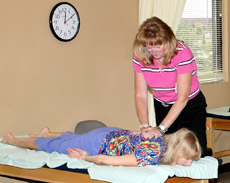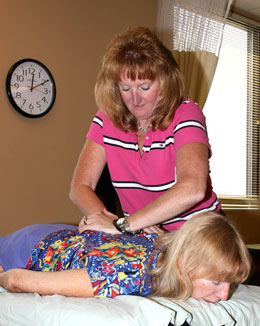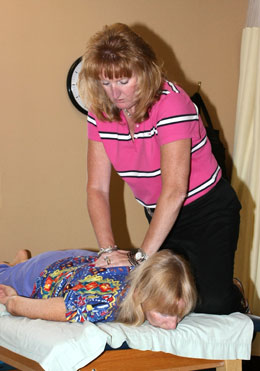Manual Therapy Polaris Physical Therapy
 “At Polaris Physical Therapy, advanced manual therapy techniques are used for relief of spine, muscle, joint and bone disorders and to put your body in balance.”
“At Polaris Physical Therapy, advanced manual therapy techniques are used for relief of spine, muscle, joint and bone disorders and to put your body in balance.”
Manual Therapy techniques are specialized hands on treatments designed to decrease pain and improve range of motion and flexibility, by “freeing up” restrictions in the body that create poor, awkward movements and generate pain. These techniques are difficult to explain in layman’s terms, but are usually gentle and can be more effective than traditional modality based treatment plans alone. Whether your condition is painful, disabling, or simply a hindrance to doing what you love, we specialize in treatment, recovery and long-term prevention programs tailored to fit your life.
Our focus is on the whole body and its mechanics. We find limitations or restrictions in your body and prioritize them, releasing them in a specific sequence dealing with the greatest restriction first. This most restricted area may be distant to the patient’s area of chief complaint, but do not worry. This total body approach is based on the principle that dominant areas of restrictions may cause excessive stresses on other areas of the body and throw off ‘balance’ in the body creating compensatory, awkward movements that are usually the cause of pain in the area of the body for which the patient is seeking relief. The success of this approach lies in the ability of the therapist to identify the patient’s chief restrictions. We’ll discuss some of the specific techniques we use below so that you can better understand the approach and its benefits.
Positional Release Therapy or Strain Counterstrain, is a manual therapy technique that restores a muscle to its normal resting tone. Trauma or injury creates spasms, hyperactivity, hypertonus, or guarding in the soft tissue surrounding the area of pain and cause compensatory, awkward movements. The correction of this dysfunctional tone is done by finding these specific areas of tense, tender, and edematous muscles and fascial tissue and placing the patient into positions of comfort that approximate the origin and insertion of the hypertonic muscle. Patients are held in these positions of comfort for 90 seconds to 2 minutes. In doing so, the over activity in the muscle spindle is inhibited and allows “resetting” of normal tonus in the muscle or muscle relaxation and more normal resting tone. The process is completed by slowly and passively returning the patient back to a neutral position. The result is readiness for the muscle to tolerate a gentle home program of stretching related specifically to the areas that were released, and previously dysfunctional. Thus, each patient gets his/her own individualized program based on each corrective session.
Mobilization, a component of manual therapy, consists of a skilled therapist passively moving joints and associated soft-tissue structures to relieve tension and therefore relieve pain and increase motion and function. They are techniques that must observe the biomechanics of the joint in question as well as laws of physiological motion and component motions in order to be safe and effective. Mobilization techniques are mechanical in that they are employed into the range of restriction. These can be more uncomfortable, but are necessary to restore normal function and stretch tissue and reduce the amount of adhesions in the area of the joint that has become painful and restricted by the adhesions. Treatments of this kind increase joint mobility, decrease pain and therefore increase range of motion and restores function.
Muscle Energy Techniques (MET) are a class of soft tissue osteopathic manipulation methods or direct techniques guided by precise, controlled, patient initiated, isometric contractions, designed to treat joint hypomobility or stiffness. They can restore proper biomechanical and physiological function to the joint or joints that are limited. Again, a thorough whole body screening or assessment is necessary each session to find these areas of restriction or dysfunction. Treatment includes placing patients in varying positions to engage or find the barrier of the restriction before asking the patient to perform an isometric contraction to pull the restricted segment into a new motion barrier. The isometric contraction is performed in a precisely controlled direction against a precisely controlled counterforce by the therapist. Again this is a slow, usually pain free and patient/therapist guided technique. It usually requires at least 3 repetitions to reset the original barrier to a more normal endpoint. It is appropriate for patients whose symptoms are aggravated by certain postures or position. The result is improved spinal or joint mobility without the need for passive manipulation. Each session ends with an assessment of the outcome of the manual techniques. This can be very rewarding for the patient seeing dramatic changes in mobility and reduction of pain from session to session.
Myfascial Release techniques are manual techniques that affect fascia or connective tissue restrictions. This involves applying varying amounts of pressure (usually very gentle) and mobilizing the tissues to reduce the thickness of and tightness of two fascia layers. The end result again is increase in mobility, decrease in inflammation and therefore increase in function and decrease in pain.
All techniques are performed by a trained physical therapist following a complete and thorough evaluation and ongoing assessments each session. Determination of which manual technique is necessary is driven by what limits are present and patient tolerance. Once the process is complete, and tone becomes more normal, cooperation from the patient is necessary and key to complete pain relief and restoration of function. A regular regime of exercises at home is the only way to reach optimal return to function, whether your goals are return to work, sport or for just normalcy in daily function.
To learn more about Manual Therapy, or to schedule an appointment with a Marden professional, contact Polaris Physical Therapy today.



 “At Polaris Physical Therapy, advanced manual therapy techniques are used for relief of spine, muscle, joint and bone disorders and to put your body in balance.”
“At Polaris Physical Therapy, advanced manual therapy techniques are used for relief of spine, muscle, joint and bone disorders and to put your body in balance.”




